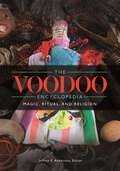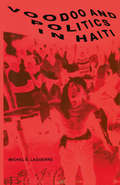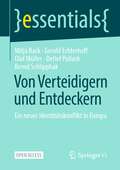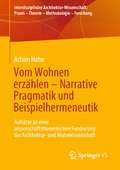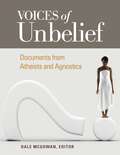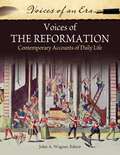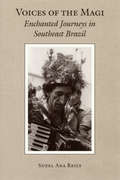- Table View
- List View
Voodoo: The History of a Racial Slur
by Danielle N. BoazCoined in the middle of the nineteenth century, the term "voodoo" has been deployed largely by people in the U.S. to refer to spiritual practices--real or imagined--among people of African descent. "Voodoo" is one way that white people have invoked their anxieties and stereotypes about Black people--to call them uncivilized, superstitious, hypersexual, violent, and cannibalistic. In this book, Danielle Boaz explores public perceptions of "voodoo" as they have varied over time, with an emphasis on the intricate connection between stereotypes of "voodoo" and debates about race and human rights. The term has its roots in the U.S. Civil War in the 1860s, especially following the Union takeover of New Orleans, when it was used to propagate the idea that Black Americans held certain "superstitions" that allegedly proved that they were unprepared for freedom, the right to vote, and the ability to hold public office. Similar stereotypes were later extended to Cuba and Haiti in the late nineteenth and early twentieth centuries. In the 1930s, Black religious movements like the Moorish Science Temple and the Nation of Islam were derided as "voodoo cults." More recently, ideas about "voodoo" have shaped U.S. policies toward Haitian immigrants in the 1980s, and international responses to rituals to bind Nigerian women to human traffickers in the twenty-first century. Drawing on newspapers, travelogues, magazines, legal documents, and books, Boaz shows that the term "voodoo" has often been a tool of racism, colonialism, and oppression.
Voodoo: The History of a Racial Slur
by Danielle N. BoazCoined in the middle of the nineteenth century, the term "voodoo" has been deployed largely by people in the U.S. to refer to spiritual practices--real or imagined--among people of African descent. "Voodoo" is one way that white people have invoked their anxieties and stereotypes about Black people--to call them uncivilized, superstitious, hypersexual, violent, and cannibalistic. In this book, Danielle Boaz explores public perceptions of "voodoo" as they have varied over time, with an emphasis on the intricate connection between stereotypes of "voodoo" and debates about race and human rights. The term has its roots in the U.S. Civil War in the 1860s, especially following the Union takeover of New Orleans, when it was used to propagate the idea that Black Americans held certain "superstitions" that allegedly proved that they were unprepared for freedom, the right to vote, and the ability to hold public office. Similar stereotypes were later extended to Cuba and Haiti in the late nineteenth and early twentieth centuries. In the 1930s, Black religious movements like the Moorish Science Temple and the Nation of Islam were derided as "voodoo cults." More recently, ideas about "voodoo" have shaped U.S. policies toward Haitian immigrants in the 1980s, and international responses to rituals to bind Nigerian women to human traffickers in the twenty-first century. Drawing on newspapers, travelogues, magazines, legal documents, and books, Boaz shows that the term "voodoo" has often been a tool of racism, colonialism, and oppression.
The Voodoo Encyclopedia: Magic, Ritual, and Religion
by Jeffrey E. AndersonThis compelling reference work introduces the religions of Voodoo, a onetime faith of the Mississippi River Valley, and Vodou, a Haitian faith with millions of adherents today.Unlike its fictional depiction in zombie films and popular culture, Voodoo is a full-fledged religion with a pantheon of deities, a priesthood, and communities of believers. Drawing from the expertise of contemporary practitioners, this encyclopedia presents the history, culture, and religion of Haitian Vodou and Mississippi Valley Voodoo. Though based primarily in these two regions, the reference looks at Voodoo across several cultures and delves into related religions, including African Vodu, African Diasporic Religions, and magical practices like hoodoo.Through roughly 150 alphabetical entries, the work describes various aspects of Voodoo in Louisiana and Haiti, covering topics such as important places, traditions, rituals, and items used in ceremonies. Contributions from scholars in the field provide a comprehensive overview of the subject from various perspectives and address the deities and ceremonial acts. The book features an extensive collection of primary sources and a selected, general bibliography of print and electronic resources.
The Voodoo Encyclopedia: Magic, Ritual, and Religion
by Jeffrey E. AndersonThis compelling reference work introduces the religions of Voodoo, a onetime faith of the Mississippi River Valley, and Vodou, a Haitian faith with millions of adherents today.Unlike its fictional depiction in zombie films and popular culture, Voodoo is a full-fledged religion with a pantheon of deities, a priesthood, and communities of believers. Drawing from the expertise of contemporary practitioners, this encyclopedia presents the history, culture, and religion of Haitian Vodou and Mississippi Valley Voodoo. Though based primarily in these two regions, the reference looks at Voodoo across several cultures and delves into related religions, including African Vodu, African Diasporic Religions, and magical practices like hoodoo.Through roughly 150 alphabetical entries, the work describes various aspects of Voodoo in Louisiana and Haiti, covering topics such as important places, traditions, rituals, and items used in ceremonies. Contributions from scholars in the field provide a comprehensive overview of the subject from various perspectives and address the deities and ceremonial acts. The book features an extensive collection of primary sources and a selected, general bibliography of print and electronic resources.
Voodoo and Politics in Haiti
by Michel S. LaguerreNot only does this book give a well-researched account of the politicization of Haitian Voodoo and the Voodooization of Haitian politics, it also lays the ground for the development of creative policies by the state vis-a-vis the cult. It is an indispensable research tool for the students of Afro-American, Caribbean and African societies in particular, and for religionists and political scientists in general.
Von Verteidigern und Entdeckern: Ein neuer Identitätskonflikt in Europa (essentials)
by Mitja Back Gerald Echterhoff Olaf Müller Detlef Pollack Bernd SchlipphakDieses Open-Access-Buch bietet eine Einführung in den Identitätskonflikt zwischen Verteidigern und Entdeckern. Basierend auf einer Studie mit 5000 Befragten aus vier europäischen Ländern zeigen die Autoren, dass sich Verteidiger und Entdecker im Hinblick auf ihre Zugehörigkeitskonzepte und das Ausmaß wahrgenommener Bedrohung durch Muslime und Geflüchtete unterscheiden. Differenzen zwischen beiden Gruppen lassen sich auch für die jeweils wahrgenommene gesellschaftliche Marginalisierung und politische Repräsentation finden. Die Studie weist zudem nach, dass mit verschiedenen Positionen im Identitätskonflikt auch unterschiedliche Konzepte von Demokratie verbunden werden.
Vom Wohnen erzählen – Narrative Pragmatik und Beispielhermeneutik: Aufsätze zu einer wissenschaftstheoretischen Fundierung der Architektur- und Wohnwissenschaft (Interdisziplinäre Architektur-Wissenschaft: Praxis – Theorie – Methodologie – Forschung)
by Achim HahnDie Beiträge dieses Bandes vereinigen in sich die Aufgabe, ein überzeugendes und kritisches wissenschaftliches Konzept vorzulegen, das aussichtsreich und nachvollziehbar Bedingungen formuliert und Möglichkeiten aufzeigt, den „komplexen Sitz“ einer beherbergenden Architektur im Leben methodisch kontrolliert zu erkunden.
Volume 15, Tome II: Classicism to Enthusiasm (Kierkegaard Research: Sources, Reception and Resources)
by Steven M. Emmanuel William McDonaldKierkegaard’s Concepts is a comprehensive, multi-volume survey of the key concepts and categories that inform Kierkegaard’s writings. Each article is a substantial, original piece of scholarship, which discusses the etymology and lexical meaning of the relevant Danish term, traces the development of the concept over the course of the authorship, and explains how it functions in the wider context of Kierkegaard’s thought. Concepts have been selected on the basis of their importance for Kierkegaard’s contributions to philosophy, theology, the social sciences, literature and aesthetics, thereby making this volume an ideal reference work for students and scholars in a wide range of disciplines.
Volume 15, Tome II: Classicism to Enthusiasm (Kierkegaard Research: Sources, Reception and Resources)
by Steven M. Emmanuel William McDonaldKierkegaard’s Concepts is a comprehensive, multi-volume survey of the key concepts and categories that inform Kierkegaard’s writings. Each article is a substantial, original piece of scholarship, which discusses the etymology and lexical meaning of the relevant Danish term, traces the development of the concept over the course of the authorship, and explains how it functions in the wider context of Kierkegaard’s thought. Concepts have been selected on the basis of their importance for Kierkegaard’s contributions to philosophy, theology, the social sciences, literature and aesthetics, thereby making this volume an ideal reference work for students and scholars in a wide range of disciplines.
Volume 10, Tome III: Catholic and Jewish Theology (Kierkegaard Research: Sources, Reception and Resources)
by Jon StewartKierkegaard has always enjoyed a rich reception in the fields of theology and religious studies. This reception might seem obvious given that he is one of the most important Christian writers of the nineteenth century, but Kierkegaard was by no means a straightforward theologian in any traditional sense. He had no enduring interest in some of the main fields of theology such as church history or biblical studies, and he was strikingly silent on many key Christian dogmas. Moreover, he harbored a degree of animosity towards the university theologians and churchmen of his own day. Despite this, he has been a source of inspiration for numerous religious writers from different denominations and traditions. Tome III explores the reception of Kierkegaard's thought in the Catholic and Jewish theological traditions. In the 1920s Kierkegaard's intellectual and spiritual legacy became widely discussed in the Catholic Hochland Circle, whose members included Theodor Haecker, Romano Guardini, Alois Dempf and Peter Wust. Another key figure of the mid-war years was the prolific Jesuit author Erich Przywara. During and especially after World War II Kierkegaard's ideas found an echo in the works of several trend-setting Catholic theologians of the day such as Hans Urs von Balthasar, Henri de Lubac and the popular spiritual author Thomas Merton. The second part of Tome III focuses on the reception of Kierkegaard's thought in the Jewish theological tradition, introducing the reader to authors who significantly shaped Jewish religious thought both in the United States and in Israel. These theologians represent a variety of religious and political backgrounds: the spiritual world of Hasidism, Modern Orthodox Judaism of Mithnaggedic origin, and Modern Religious Zionism.
Volume 10, Tome III: Catholic and Jewish Theology (Kierkegaard Research: Sources, Reception and Resources)
by Jon StewartKierkegaard has always enjoyed a rich reception in the fields of theology and religious studies. This reception might seem obvious given that he is one of the most important Christian writers of the nineteenth century, but Kierkegaard was by no means a straightforward theologian in any traditional sense. He had no enduring interest in some of the main fields of theology such as church history or biblical studies, and he was strikingly silent on many key Christian dogmas. Moreover, he harbored a degree of animosity towards the university theologians and churchmen of his own day. Despite this, he has been a source of inspiration for numerous religious writers from different denominations and traditions. Tome III explores the reception of Kierkegaard's thought in the Catholic and Jewish theological traditions. In the 1920s Kierkegaard's intellectual and spiritual legacy became widely discussed in the Catholic Hochland Circle, whose members included Theodor Haecker, Romano Guardini, Alois Dempf and Peter Wust. Another key figure of the mid-war years was the prolific Jesuit author Erich Przywara. During and especially after World War II Kierkegaard's ideas found an echo in the works of several trend-setting Catholic theologians of the day such as Hans Urs von Balthasar, Henri de Lubac and the popular spiritual author Thomas Merton. The second part of Tome III focuses on the reception of Kierkegaard's thought in the Jewish theological tradition, introducing the reader to authors who significantly shaped Jewish religious thought both in the United States and in Israel. These theologians represent a variety of religious and political backgrounds: the spiritual world of Hasidism, Modern Orthodox Judaism of Mithnaggedic origin, and Modern Religious Zionism.
Volume 10, Tome II: Anglophone and Scandinavian Protestant Theology (Kierkegaard Research: Sources, Reception and Resources)
by Jon StewartKierkegaard has always enjoyed a rich reception in the fields of theology and religious studies. This reception might seem obvious given that he is one of the most important Christian writers of the nineteenth century, but Kierkegaard was by no means a straightforward theologian in any traditional sense. He had no enduring interest in some of the main fields of theology such as church history or biblical studies, and he was strikingly silent on many key Christian dogmas. Moreover, he harbored a degree of animosity towards the university theologians and churchmen of his own day. Despite this, he has been a source of inspiration for numerous religious writers from different denominations and traditions. Tome II is dedicated to tracing Kierkegaard's influence in Anglophone and Scandinavian Protestant religious thought. Kierkegaard has been a provocative force in the English-speaking world since the early twentieth century, inspiring almost contradictory receptions. In Britain, before World War I, the few literati who were familiar with his work tended to assimilate Kierkegaard to the heroic individualism of Ibsen and Nietzsche. In the United States knowledge of Kierkegaard was introduced by Scandinavian immigrants who brought with them a picture of the Dane as much more sympathetic to traditional Christianity. The interpretation of Kierkegaard in Britain and America during the early and mid-twentieth century generally reflected the sensibilities of the particular theological interpreter. Anglican theologians generally found Kierkegaard to be too one-sided in his critique of reason and culture, while theologians hailing from the Reformed tradition often saw him as an insightful harbinger of neo-orthodoxy. The second part of Tome II is dedicated to the Kierkegaard reception in Scandinavian theology, featuring articles on Norwegian and Swedish theologians influenced by Kierkegaard.
Volume 10, Tome II: Anglophone and Scandinavian Protestant Theology (Kierkegaard Research: Sources, Reception and Resources)
by Jon StewartKierkegaard has always enjoyed a rich reception in the fields of theology and religious studies. This reception might seem obvious given that he is one of the most important Christian writers of the nineteenth century, but Kierkegaard was by no means a straightforward theologian in any traditional sense. He had no enduring interest in some of the main fields of theology such as church history or biblical studies, and he was strikingly silent on many key Christian dogmas. Moreover, he harbored a degree of animosity towards the university theologians and churchmen of his own day. Despite this, he has been a source of inspiration for numerous religious writers from different denominations and traditions. Tome II is dedicated to tracing Kierkegaard's influence in Anglophone and Scandinavian Protestant religious thought. Kierkegaard has been a provocative force in the English-speaking world since the early twentieth century, inspiring almost contradictory receptions. In Britain, before World War I, the few literati who were familiar with his work tended to assimilate Kierkegaard to the heroic individualism of Ibsen and Nietzsche. In the United States knowledge of Kierkegaard was introduced by Scandinavian immigrants who brought with them a picture of the Dane as much more sympathetic to traditional Christianity. The interpretation of Kierkegaard in Britain and America during the early and mid-twentieth century generally reflected the sensibilities of the particular theological interpreter. Anglican theologians generally found Kierkegaard to be too one-sided in his critique of reason and culture, while theologians hailing from the Reformed tradition often saw him as an insightful harbinger of neo-orthodoxy. The second part of Tome II is dedicated to the Kierkegaard reception in Scandinavian theology, featuring articles on Norwegian and Swedish theologians influenced by Kierkegaard.
Volume 10, Tome I: German Protestant Theology (Kierkegaard Research: Sources, Reception and Resources)
by Jon StewartKierkegaard has always enjoyed a rich reception in the fields of theology and religious studies. This reception might seem obvious given that he is one of the most important Christian writers of the nineteenth century, but Kierkegaard was by no means a straightforward theologian in any traditional sense. He had no enduring interest in some of the main fields of theology such as church history or biblical studies, and he was strikingly silent on many key Christian dogmas. Moreover, he harbored a degree of animosity towards the university theologians and churchmen of his own day. Despite this, he has been a source of inspiration for numerous religious writers from different denominations and traditions. Tome I is dedicated to the reception of Kierkegaard among German Protestant theologians and religious thinkers. The writings of some of these figures turned out to be instrumental for Kierkegaard's breakthrough internationally shortly after the turn of the twentieth century. Leading figures of the movement of 'dialectical theology' such as Karl Barth, Emil Brunner, Paul Tillich and Rudolf Bultmann spawned a steadily growing awareness of and interest in Kierkegaard's thought among generations of German theology students. Emanuel Hirsch was greatly influenced by Kierkegaard and proved instrumental in disseminating his thought by producing the first complete German edition of Kierkegaard's published works. Both Barth and Hirsch established unique ways of reading and appropriating Kierkegaard, which to a certain degree determined the direction and course of Kierkegaard studies right up to our own times.
Volume 10, Tome I: German Protestant Theology (Kierkegaard Research: Sources, Reception and Resources)
by Jon StewartKierkegaard has always enjoyed a rich reception in the fields of theology and religious studies. This reception might seem obvious given that he is one of the most important Christian writers of the nineteenth century, but Kierkegaard was by no means a straightforward theologian in any traditional sense. He had no enduring interest in some of the main fields of theology such as church history or biblical studies, and he was strikingly silent on many key Christian dogmas. Moreover, he harbored a degree of animosity towards the university theologians and churchmen of his own day. Despite this, he has been a source of inspiration for numerous religious writers from different denominations and traditions. Tome I is dedicated to the reception of Kierkegaard among German Protestant theologians and religious thinkers. The writings of some of these figures turned out to be instrumental for Kierkegaard's breakthrough internationally shortly after the turn of the twentieth century. Leading figures of the movement of 'dialectical theology' such as Karl Barth, Emil Brunner, Paul Tillich and Rudolf Bultmann spawned a steadily growing awareness of and interest in Kierkegaard's thought among generations of German theology students. Emanuel Hirsch was greatly influenced by Kierkegaard and proved instrumental in disseminating his thought by producing the first complete German edition of Kierkegaard's published works. Both Barth and Hirsch established unique ways of reading and appropriating Kierkegaard, which to a certain degree determined the direction and course of Kierkegaard studies right up to our own times.
Volume 10: Philosophy of Religion (Contemporary Philosophy: A New Survey #10)
by Guttorm FløistadThe present volume is a continuation of the series Contemporary Philosophy. As with the earlier volumes in the series, the present Chronicles purport to give a survey of significant trends in contemporary philosophy. The need for such surveys has, I believe, increased rather than decreased over the years. The philosophical scene appears, for various reasons, more complex than ever before. The continuing process of specialization in most branches, the increasing contact between p- losophers from various cultures, the emergence of new schools of thought, particularly in philosophical logic and in the philosophy of language and ethics, and the increasing attention being paid to the h- tory of philosophy in discussions of contemporary problems, are the most important contributing factors. Surveys of the present kind are a valuable source of knowledge of this complexity. The surveys may therefore help to strengthen the Socratic element of modern philosophy, the intercultural dialogue or Kommunikationsgemeinschaft. So far, nine volumes have been published in this series, viz. P- losophy of Language and Philosophical Logic (Volume 1), Philosophy of Science (Volume 2), Philosophy of Action (Volume 3), Philosophy of Mind (Volume 4), African Philosophy (Volume 5), Medieval Age P- losophy (Volumes 6/1 and 6/2), Asian Philosophy (Volume 7), Philo- phy of Latin America (Volume 8), and Aesthetics and Philosophy of Art (Volume 9).
Voltaire Against the Jews, or The Limits of Toleration (Palgrave Critical Studies of Antisemitism and Racism)
by Marco PiazzaThis book challenges Voltaire’s doctrine of toleration. Can a Jew be a philosopher? And if so, at what cost? It seeks to provide an organic interpretation of Voltaire’s attitude towards Jews, problematising the issue against the background of his theory of toleration. To date, no monograph entirely dedicated to this theme has been written. This book attempts to provide an answer to the crucial questions that have emerged in the past fifty years through a process of reading and analysis that starts with the publication of Des Juifs (1756), and ends with the posthumous publication of the apocryphal article ‘Juifs’ in the Kehl edition of the Dictionnaire Philosophique (1784).
Volkseigenes Erinnern: Die DDR im sozialen Gedächtnis (Soziales Gedächtnis, Erinnern und Vergessen – Memory Studies)
by Hanna Haag Pamela Heß Nina LeonhardDie Beiträge untersuchen aus unterschiedlichen Blickwinkeln die Modalitäten der selektiven Inanspruchnahme von DDR-bezogenen Wissensbeständen für individuelle wie kollektive Sinnbildung, wie sie sich im Verlauf der letzten zweieinhalb Jahrzehnte im vereinigten Deutschland herausgebildet haben. Hierbei stehen weniger die ‚offiziellen‘, das heißt die institutionell abgesicherten Sichtweisen auf die DDR im Fokus der Betrachtung. Vielmehr nehmen die Autorinnen und Autoren Formen der sozialen Aneignung (oder auch: der Nicht-Aneignung) dieser sowie anderer, teilweise noch wenig untersuchter DDR-bezogener Wissensbestände ‚von unten‘ in den Blick und liefern so Erkenntnisse über die Formierung der DDR als Gegenstand sozialer Erinnerungs- und Vergessensprozesse seit 1990.
Voices of Unbelief: Documents from Atheists and Agnostics (Voices Of An Era Ser.)
by Dale McGowanThis book spotlights individual expressions of atheist, agnostic, and secular humanist opinion—both public and private—to shed light on the phenomenon of religious disbelief throughout history and across cultures.Voices of Unbelief: Documents from Atheists and Agnostics is the first anthology to provide comprehensive, annotated readings on atheism and unbelief expressly for high school and college students. This diverse compilation brings together letters, essays, diary entries, book excerpts, blogs, monologues, and other writings by atheists and agnostics, both through the centuries and across continents and cultures.Unlike most other anthologies of atheist writings, the collection goes beyond public proclamations of well-known individuals to include the personal voices of unbelievers from many walks of life. While readers will certainly find excerpts from the published canon here, they will also discover personal documents that testify to the experience of living outside of the religious mainstream. The book presents each document in its historical context, enriched with an introduction, key questions, and activities that will help readers understand the past and navigate current controversies revolving around religious belief.
Voices of Unbelief: Documents from Atheists and Agnostics
by Dale McGowanThis book spotlights individual expressions of atheist, agnostic, and secular humanist opinion—both public and private—to shed light on the phenomenon of religious disbelief throughout history and across cultures.Voices of Unbelief: Documents from Atheists and Agnostics is the first anthology to provide comprehensive, annotated readings on atheism and unbelief expressly for high school and college students. This diverse compilation brings together letters, essays, diary entries, book excerpts, blogs, monologues, and other writings by atheists and agnostics, both through the centuries and across continents and cultures.Unlike most other anthologies of atheist writings, the collection goes beyond public proclamations of well-known individuals to include the personal voices of unbelievers from many walks of life. While readers will certainly find excerpts from the published canon here, they will also discover personal documents that testify to the experience of living outside of the religious mainstream. The book presents each document in its historical context, enriched with an introduction, key questions, and activities that will help readers understand the past and navigate current controversies revolving around religious belief.
Voices of the Ritual: Devotion to Female Saints and Shrines in the Holy Land (Oxford Ritual Studies)
by Nurit StadlerVoices of the Ritual analyzes the revival of rituals performed at female saint shrines in the Middle East. In the midst of turbulent political contention over land and borders, Nurit Stadler shows, religious minorities lay claim to space through rituals enacted at sacred spaces in the Holy Land. Using ethnographic analysis, Stadler explores the rise of these rituals, their focus on the body, female materiality, and their place in the Israeli-Palestinian landscape. Stadler examines the varied features of the practice and implications of the rituals, looking at themes of femininity and material experience. She considers the role of the body in rituals that represent the act of birth or the circle of life and that aim to foster an intimate connection between the female saint and her worshippers. Stadler underscores the political, cultural, and spatial elements of this practice, bringing attention to how religious minorities (Jews, Christians, Muslims, and Druze, among others) have utilized these rituals to assert their right to the land. Voices of the Ritual offers a valuable assessment of religious ritual practice that encrypts female themes into a landscape that has historically been defined by war and conflict.
Voices of the Ritual: Devotion to Female Saints and Shrines in the Holy Land (Oxford Ritual Studies)
by Nurit StadlerVoices of the Ritual analyzes the revival of rituals performed at female saint shrines in the Middle East. In the midst of turbulent political contention over land and borders, Nurit Stadler shows, religious minorities lay claim to space through rituals enacted at sacred spaces in the Holy Land. Using ethnographic analysis, Stadler explores the rise of these rituals, their focus on the body, female materiality, and their place in the Israeli-Palestinian landscape. Stadler examines the varied features of the practice and implications of the rituals, looking at themes of femininity and material experience. She considers the role of the body in rituals that represent the act of birth or the circle of life and that aim to foster an intimate connection between the female saint and her worshippers. Stadler underscores the political, cultural, and spatial elements of this practice, bringing attention to how religious minorities (Jews, Christians, Muslims, and Druze, among others) have utilized these rituals to assert their right to the land. Voices of the Ritual offers a valuable assessment of religious ritual practice that encrypts female themes into a landscape that has historically been defined by war and conflict.
Voices of the Reformation: Contemporary Accounts of Daily Life (Voices of an Era)
by John A. WagnerThis fascinating collection of primary source documents furnishes the accounts—in their own words—of those who initiated, advanced, or lived through the Reformation.Starting in 1500, Europe transformed from a united Christendom into a continent bitterly divided between Catholicism and Protestantism by the end of the century. This illuminating text reveals what happened during that period by presenting the social, religious, economic, political, and cultural life of the European Reformation of the 16th century in the words of those who lived through it. Detailed and comprehensive, the work includes 60 primary source documents that shed light on the character, personalities, and events of that time and provides context, questions, and activities for successfully incorporating these documents into academic research and reading projects. A special section provides guidelines for better evaluating and understanding primary documents. Topics include late medieval religion, Martin Luther, reformation in Germany and the Peasants' War, the rise of Calvinism, and the English Reformation.
Voices of the Reformation: Contemporary Accounts of Daily Life (Voices of an Era)
by John A. WagnerThis fascinating collection of primary source documents furnishes the accounts—in their own words—of those who initiated, advanced, or lived through the Reformation.Starting in 1500, Europe transformed from a united Christendom into a continent bitterly divided between Catholicism and Protestantism by the end of the century. This illuminating text reveals what happened during that period by presenting the social, religious, economic, political, and cultural life of the European Reformation of the 16th century in the words of those who lived through it. Detailed and comprehensive, the work includes 60 primary source documents that shed light on the character, personalities, and events of that time and provides context, questions, and activities for successfully incorporating these documents into academic research and reading projects. A special section provides guidelines for better evaluating and understanding primary documents. Topics include late medieval religion, Martin Luther, reformation in Germany and the Peasants' War, the rise of Calvinism, and the English Reformation.
Voices of the Magi: Enchanted Journeys in Southeast Brazil (Chicago Studies in Ethnomusicology)
by Suzel ReilyVoices of the Magi explores the popular Catholic musical ensembles of southeastern Brazil known as folias de reis (companies of kings). Composed predominantly of low-income workers, the folias reenact the journey of the Wise Men to Bethlehem and back to the Orient, as they roam from house to house, singing to bless the families they visit in exchange for food and money. These gifts, in turn, are used to prepare a festival on Kings' Day, January 6, to which all who contributed are invited. Focusing on urban folias, Suzel Ana Reily shows how participants use the ritual journeys and musical performances of the folias to create sacred spheres distinct from, yet intimately related to, their everyday world. Reily calls this practice "enchantment" and argues that it allows the folia communities to temporarily make the social ideals of mutual reciprocity and equality embodied in their religious beliefs a reality. The contrast between their ritual experiences and the daily lives of these impoverished workers, in turn, reinforces the religious convictions of these devotees of the music of the Magi.

